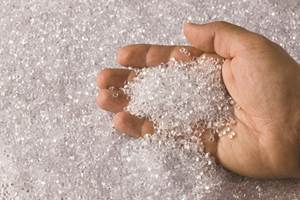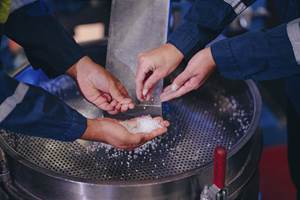Prices of PE, PP, PS Up; Flat-to-Down for PVC, PET
Potential for short-lived upward pricing trajectory possible for the polyolefins, PS.
‘Mayday’ proved interesting in commodity resin pricing with prices increases underway for PE, PP, and PS, and at least slightly downward for PVC and PET. While higher global crude oil prices were a variable for successful or attempted price initiatives, domestic market fundamentals included ample resin supplies, relatively sluggish demand, and in most cases, lower feedstock costs.
Take a look at how purchasing consultants from Resin Technology, Inc. (RTi), Fort Worth, Texas; senior editors from Houston-based PetroChemWire (PCW); and CEO Michael Greenberg of the Plastics Exchange in Chicago, see things shaking out:
PE: Prices were largely reported to have rolled over last month, but in early May, moved up 3¢/lb, with suppliers’ nominated increase not quite reaching a five-month milestone. Mike Burns, RTi’s v.p. of PE markets, notes that this increase made it through while global crude oil prices were at a six-month high and global ethylene prices were at a four-month low. He also adds that supplier inventories in March grew by 117 million lb, with no reported unplanned shutdowns in PE production.
Looking ahead, both Burns and PCW senior editor David Barry see suppliers’ record resin inventories could serve to keep price flat. Says Barry, “There is a lot of resin around and this is still a buyers’ market and will be more so as the year progresses.” All sources noted that that spot PE prices moved up in April by at least 1¢/lb. Burns notes that the delta between contract and spot prices, which is typically around 4¢/lb, stood at closer to 10¢/lb in April.
The Plastics Exchange’s Greenberg reported, “Spot polyethylene trading activity was very good as April marched on. Completed volumes were a bit above average as buyers, feeling that prices were starting to tick higher, came looking for deals. HDPE and LLDPE film resins added a half-cent, while LDPE for both film and injection and LLDPE for injection were all up a full penny. Prompt availability tightened as resellers’ inventories have thinned and some suppliers withheld offers in anticipation of a better selling environment in May.”
The strength of domestic demand by end of April was unclear. Said PCW’s Barry, “Domestic demand indications were mixed—some market sectors were reporting that demand was below expectations but by no means bad.” He noted that the recent capacity additions continued to be felt most acutely in the film sector, which was seeing ongoing market share battles. Higher crude oil prices and the resulting upward pressure on international naphtha-based PE values were seen as the primary driver for the domestic PE contract increase. In contrast, exports were very clearly on the rise, and Greenberg reported that they now have reached 33% of all U.S. PE sales—a trend that will continue to grow and remain crucial to soaking up new production that will come online.
PP: Prices rolled over for the second consecutive month in April, but a wind of change is on the horizon. Both Scott Newell, RTi’s v.p. of PP markets and PCW’s Barry see PP prices bottoming out and venture that May PP prices had potential to move up 3-5¢/lb. This driven by solely upwards movement in spot propylene monomer—moving from a low of 35.5¢/lb to 38.5¢/lb. According to The Plastic Exchange’s Greenberg, the forward pricing moved in tandem with December monomer showing around 43¢/lb. He noted that based on the spot prices in early May, late-settling May monomer contracts had a likelihood of moving up by as much as 5-6¢/lb,
Barry reports that PP spot prices were up 1-2¢/lb by end of April and demand began to pick up as news of higher propylene monomer spot prices were reported—that uptick made it clear that May PP contract prices would rise this month. Supply was balanced to snug. While some suppliers were dealing with planned and unplanned maintenance outages, others were reported to be regulating output to avoid building inventory. “The feeling about PP demand is rather bullish for second quarter. At the same time, supplier PP inventories are in the mid-30 days of sale, which is pretty average going into May.”
Newell notes that by early May, it was still not clear whether domestic demand had strengthened. “Demand has been struggling all year. One variable, were strong PP imports—most were higher priced compared to current domestic PP prices, but domestic processors that committed to these import purchases did so in late fourth quarter 2018, when domestic PP prices were very high.” Yet another variable these industry pros are watching is the higher crude oil prices. Newell summarized things this way, “There is plenty of monomer and PP resin inventories, so it’s hard to know if this upward pricing movement has any legs.” Industry rumors had it that some suppliers would be coming out with price increase letters and it was unclear if a margin expansion would be included. Said Newell, “I just don’t see the market fundamentals supporting a margin increase.”
PS: Prices moved up 2-4¢/lb last month, depending on contract terms, following the 2¢/lb increase in March, according to both PCW’s Barry and Robin Chesshier, RTi’s v.p. of PE, PS and nylon 6 markets. Barry reports that styrene monomer cost based on a 30/70 spot ethylene/benzene formula moved to 26.3¢/lb by April’s end, up from 23.7¢/lb the previous month. He reports that there were indications that the higher prices were providing a headwind for April sales and driving an uptick in import business
Both industry pros say PS suppliers have been aiming to get 4¢/lb, but processors are pushing back, noting that raw materials had not risen by as much. Suppliers, in turn, have maintained that part of that increase was due to the Ohio and Mississippi river flooding that resulted in moving material via trucking which increased logistical costs, according to Chesshier, “The month of May will be interesting as the flooding has been subsiding, benzene prices dropped following a spike that followed crude oil price spikes, and domestic demand as is the case seasonally is good.” She noted that ACC figures for March showed PS plant utilization rates having dropped to under 70%, a rare occurrence, while demand remained on a normal pace. Still, she said it would not be a surprise to see suppliers attempt yet another increase this month.
PVC: Prices by end of last month appeared to be flat to slightly down. PCW’s senior editor Donna Todd, reports that suppliers were surprised that one industry pundit was predicting a drop of 2¢/lb by April’s end, whereas previous predictions were for a 1¢/lb decrease. “Were this to take place, it would wipe out suppliers’ implemented 2 ¢/lb increase implemented in February,” she reported.
Mark Kallman, RTi’s v.p. of PVC and engineering resin markets, thought a 2¢/lb reduction a bit too ambitious, but ventured that prices last month would be shown to be flat-to-down 1¢/lb. “We have an improvement in production—up 12% in March, while domestic demand dropped 2% month-over-month. At the same time, export prices dropped further as did ethylene prices for the fourth consecutive month. Nothing in this picture supports the 2 ¢/lb increase that has been sought by suppliers for the last couple of months.” Kallman noted that domestic demand in construction—which got a late start this year, was starting to improve going into this month. “We achieved higher exports in April as suppliers lowered prices to make up for slowed domestic demand.” He notes that if prices go down this month by 1¢/lb or so, conditional on economy improving, June and July might have some upward movement based on domestic demand improving, so prices would inch up by third quarter, though low ethylene prices are likely to continue.
PCW’s Todd reports that ethylene contract prices dropped by 7¢/lb from Oct. 2018 through March 2019. Moreover, industry statistics show domestic PVC sales in March to have dropped by 14.2% year-over-year, while export sales were up by 15.8% year-over-year. Todd notes that market watchers were expecting to see similar if not worse figures for the month of April.
PET: Prices for domestic bottle-grade PET ended April unchanged from late March at about 60¢/lb railcar delivered Midwest. The price rose 3-4¢/lb during the month on normal seasonal demand, according to PCW senior editor Xavier Cronin. Prices for May are expected to drop 2-3¢/lb driven by oversupply of domestic and imported PET.
Cronin quoted one market source as follows, “This is mainly driven by lower PX (paraxylene) prices caused by huge capacity coming on in Asia.” Other reasons include rising PET imports from 14 countries, including Vietnam, South Korea and South Africa, and an increase in the use of rPET flake and pellet to produce food-grade bottles, containers and packaging. Cronin ventured that PET prices for June are likely to remain flat or slightly as oversupply keeps this as a buyers’ market--despite the arrival of the warm-weather heavy consumption period of beverages in PET bottles, jugs and the like.
Related Content
Prices for PE, PS, PVC, PET Trending Flat; PP to Drop
Despite price increase nominations going into second quarter, it appeared there was potential for generally flat pricing with the exception of a major downward correction for PP.
Read MoreThe Fundamentals of Polyethylene – Part 1: The Basics
You would think we’d know all there is to know about a material that was commercialized 80 years ago. Not so for polyethylene. Let’s start by brushing up on the basics.
Read MoreFundamentals of Polyethylene – Part 3: Field Failures
Polyethylene parts can fail when an inappropriate density is selected. Let’s look at some examples and examine what happened and why.
Read MorePrices of PE, PP, PS, PVC Drop
Generally, a bottoming-out appears to be the projected pricing trajectory.
Read MoreRead Next
See Recyclers Close the Loop on Trade Show Production Scrap at NPE2024
A collaboration between show organizer PLASTICS, recycler CPR and size reduction experts WEIMA and Conair recovered and recycled all production scrap at NPE2024.
Read MoreFor PLASTICS' CEO Seaholm, NPE to Shine Light on Sustainability Successes
With advocacy, communication and sustainability as three main pillars, Seaholm leads a trade association to NPE that ‘is more active today than we have ever been.’
Read More




























